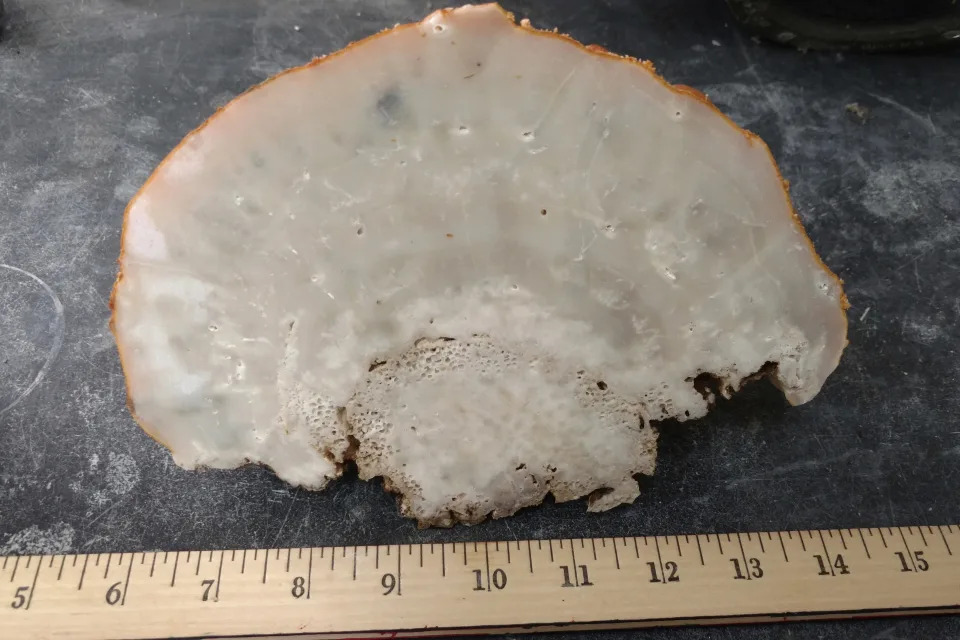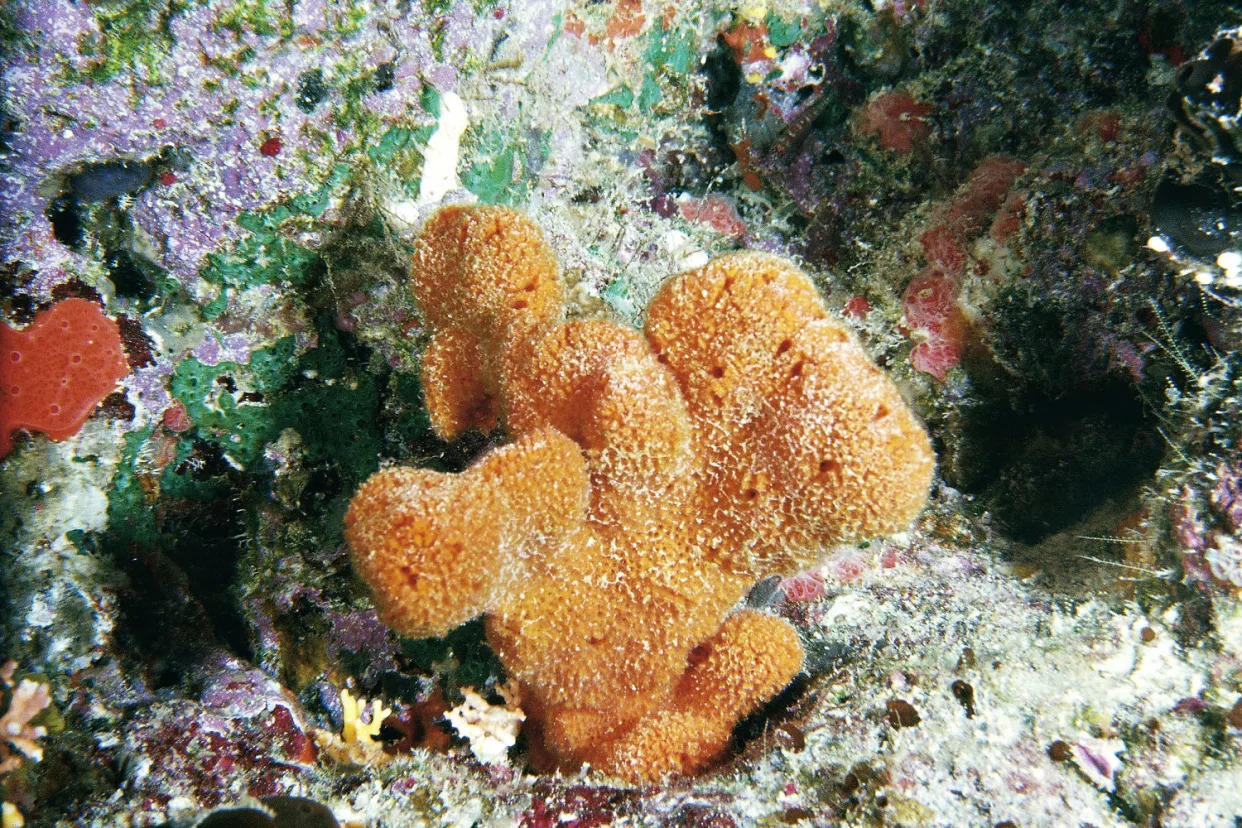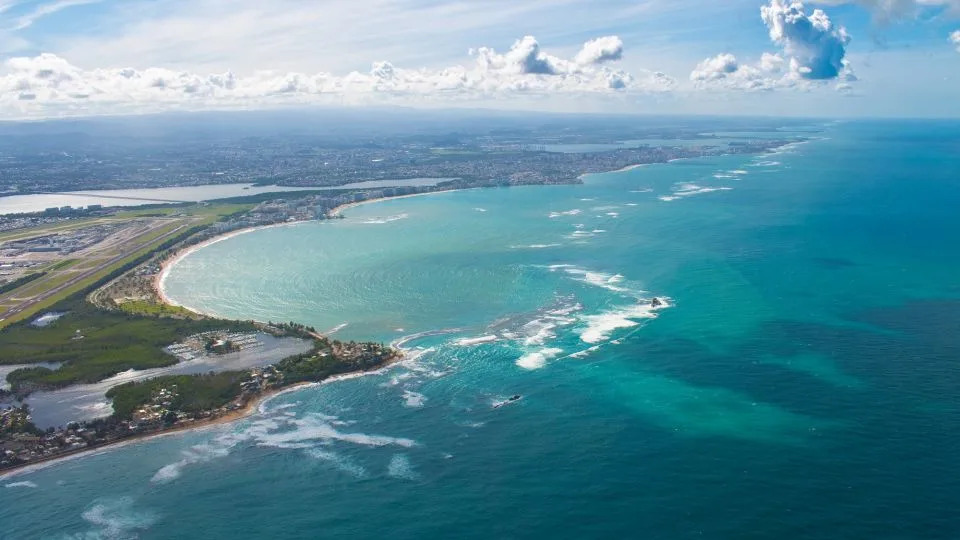SETH BORENSTEIN
Mon, February 5, 2024


A handful of centuries-old sponges from deep in the Caribbean are causing some scientists to think human-caused climate change began sooner and has heated the world more than they thought.
They calculate that the world has already gone past the internationally approved target of limiting global warming to 1.5 degrees Celsius (2.7 degrees Fahrenheit) since pre-industrial times, hitting 1.7 degrees (3.1 degrees Fahrenheit) as of 2020. They analyzed six of the long-lived sponges — simple animals that filter water — for growth records that document changes in water temperature, acidity and carbon dioxide levels in the air, according to a study in Monday’s journal Nature Climate Change.
Other scientists were skeptical of the study's claim that the world has warmed that much more than thought. But if the sponge calculations are right, there are big repercussions, the study authors said.
“The big picture is that the global warming clock for emissions reductions to minimize the risk of dangerous climate changes is being brought forward by at least a decade,” study lead author Malcolm McCulloch, a marine geochemist at the University of Western Australia. “Basically, time's running out.”
“We have a decade less than we thought,” McCulloch told The Associated Press. “It's really a diary of — what's the word? — impending disaster.”
In the past several years, scientists have noted more extreme and harmful weather — floods, storms, droughts and heat waves — than they had expected for the current level of warming. One explanation for that would be if there was more warming than scientists had initially calculated, said study co-author Amos Winter, a paleo oceanographer at Indiana State University. He said this study also supports the theory that climate change is accelerating, proposed last year by former NASA top scientist James Hansen.
“This is not good news for global climate change as it implies more warming,” said Cornell University climate scientist Natalie Mahowald, who was not part of the study.
Many sponge species live long, and as they grow they record the conditions of the environment around them in their skeletons. Scientists have long used sponges along with other proxies — tree rings, ice cores and coral — that naturally show the record of changes in the environment over centuries. Doing so helps fill in data from before the 20th century.
Sponges — unlike coral, tree rings and ice cores — get water flowing from all over through them so they can record a larger area of ecological change, Winter and McCulloch said.
They used measurements from a rare species of small and hard-shelled sponges to create a temperature record for the 1800s that differs greatly from the scientifically accepted versions used by the United Nations' Intergovernmental Panel on Climate Change. The study finds that the mid-1800s were about half a degree Celsius cooler than previously thought, with warming from heat-trapping gases kicking in about 80 years earlier than the measurements the IPCC uses. IPCC figures show warming kicking in just after 1900.
It makes sense that the warming started earlier than the IPCC says because by the mid-1800s the Industrial Revolution had begun and carbon dioxide was being spewed into the air, said McCulloch and Winter. Carbon dioxide and other gases from the burning of fossil fuels are what causes climate change, scientists have established.
Winter and McCulloch said these rusty orange long-lived sponges — one of them was more than 320 years old when it was collected — are special in a way that makes them an ideal measuring tool, better than what scientists used in the mid- to late 1800s.
“They are cathedrals of history, of human history, recording carbon dioxide in the the atmosphere, temperature of the water and pH of the water,” Winter said.
“They're beautiful,” he said. “They're not easy to find. You need a special team of divers to find them.”
That's because they live 100 to 300 feet deep (33 meters to 98 meters) in the dark, Winter said.
The IPCC and most scientists use temperature data for the mid-1800s that came from ships whose crews would take temperature readings by lowering wooden buckets to dip up water. Some of those measurements could be skewed depending on how the collection was done — for example, if the water was collected near a warm steamship engine. But the sponges are more accurate because scientists can track regular tiny deposits of calcium and strontium on the critters' skeleton. Warmer water would lead to more strontium compared to calcium, and and cooler water would lead to higher proportions of calcium compared to strontium, Winter said.
University of Pennsylvania climate scientist Michael Mann, who wasn't part of the study, has long disagreed with the IPCC's baseline and thinks warming started earlier. But he was still skeptical of the study's findings.
“In my view it begs credulity to claim that the instrumental record is wrong based on paleo-sponges from one region of the world. It honestly doesn't make any sense to me,” Mann said.
In a news briefing, Winter and McCulloch repeatedly defended the use of sponges as an accurate proxy for world temperature changes. They said except for the 1800s, their temperature reconstruction based on sponges matches global records from instruments and other proxies like coral, ice cores and tree rings.
And even though these sponges are only in the Caribbean, McCulloch and Winter said they are a good representation for the rest of the world because they're at a depth that doesn't get too affected by warm and cold cycles of El Nino and La Nina, and the water matches well with global ocean temperatures, McCulloch and Winter said.
Princeton University climate scientist Michael Oppenheimer, who also wasn't part of the sponge study, said even if the McCulloch team is right about a cooler baseline in the 1800s that shouldn't really change the danger levels that scientists set in their reports. That's because the danger levels “were not tied to the absolute value of preindustrial temperatures” but more about how much temperatures changed from that time, he said.
Although the study stopped at 2020 with 1.7 degrees Celsius (3.1 degrees Fahrenheit) in warming since pre-industrial times, a record hot 2023 pushes that up to 1.8 degrees (3.2 degrees Fahrenheit), McCulloch said.
“The rate of change is much faster than we thought,” McCulloch said. “We're heading into very dangerous high-risk scenarios for the future. And the only way to stop this is to reduce emissions. Urgently. Most urgently.”
___
Teresa de Miguel contributed to this report from Mexico City.
___
Read more of AP’s climate coverage at http://www.apnews.com/climate-and-environment
___
Follow Seth Borenstein on X at @borenbears
______
The Associated Press’ climate and environmental coverage receives financial support from multiple private foundations. AP is solely responsible for all content. Find AP’s standards for working with philanthropies, a list of supporters and funded coverage areas at AP.org.
Sea sponges keep climate records and the accounting is grim, new study suggests
Evan Bush
Mon, February 5, 2024

If temperature-tracking sea sponges are to be trusted, climate change has progressed much further than scientists have estimated.
A new study that uses ocean organisms called sclerosponges to measure average global temperature suggests the world has already warmed by about 1.7 degrees C over the past 300 years — at least a half degree Celsius more than the scientific consensus as laid out in United Nations reports.
The finding, published Monday in the journal Nature Climate Change, is startling, but some scientists say the study authors' conclusions extrapolated too much about global temperature than can be confidently gleaned from sea sponges.
But the study hits on an important question: How much did the world warm when fossil-fuel-powered machinery was chugging but humans were not very organized in measuring temperatures across the world? Scientists say it’s a critical question and something they need to better understand.
The authors of the study say that industrialization before 1900 had a larger impact than scientists previously realized, that its effect has been captured in the skeletons of centuries-old sponges, and that the baseline we’ve been using to talk about climate change politics has been wrong.
“Basically they show the industrial era of warming commenced earlier than we thought, in the 1860s,” Malcolm McCulloch, a lead author of the study who is a professor of geochemistry at The University of Western Australia, said of the sponges. “The big picture is that the global warming clock for emission reductions for minimizing the risk of a dangerous climate have been brought forward by at least a decade.”
Scientists not associated with the study said colleagues have been grappling with how much warming occurred in the early decades after the industrial revolution but before temperature records became more reliable.
“This isn’t the only effort to revisit what we call the preindustrial baseline and to suggest we may be missing increments of warming in the 19th century,” said Kim Cobb, a paleoclimate and oceanography expert at Brown University who is the director of the Institute at Brown for Environment and Society. “This is an area of uncertainty and importance.”
The United Nations Intergovernmental Panel on Climate Change (IPCC) in its most recent assessment of global warming estimated that global surface temperatures have risen by as much as 1.2 degrees C since preindustrial times.
Some scientists think the IPCC’s process — which requires consensus — yields conservative results. Scientists who study Earth’s ice, for example, have raised concerns that the Earth is approaching ice sheet tipping points sooner than expected and that the IPCC’s sea level rise projections are much too low.
Cobb, who did not contribute to the Nature Climate Change study, said it would take heaps of evidence to shift what scientists refer to as the preindustrial baseline, but also that other researchers have found some indications that warming before the 1900s is not accounted for adequately.
“How big this extra increment of warming truly is remains unknown right now. Is it important to study this? Could we be missing some tenths of degree — yes — that seems born out in lines of investigation over the last 6-10 years,” Cobb said.
Sclerosponges are one of many climate proxies scientists use to glean information about past climate conditions. With sclerosponges, layers of skeletal growth serve a similar purpose to marine biologists as rings within a tree serve those working in forests.
Sclerosponges grow slowly and the chemical contents of their skeleton changes as they grow, based on their surrounding temperature. That means scientists can track temperatures by looking at the ratio of strontium and calcium as the creatures steadily grow.
Every half millimeter of growth represents about two years of temperature data, the study says. The creatures can grow and add layers to their skeletons for hundreds of years.
“These are really unique specimens," McCulloch said. "The reason we’re able to get this unique data is because of the special relationship of these animals to the ambient environment.”
The study’s authors collected sponges from waters at least 100 feet deep off Puerto Rico and near the island of St. Croix, analyzed their skeletons’ chemical composition, charted their findings and compared their data against sea surface temperature measures from 1964 to 2012, finding the trends closely matched.
The sponge skeleton data dates to 1700, which is longer than reliable human records. That gives scientists a longer reference point to evaluate what temperatures were like before fossil fuels became popular. The researchers think it does a better job than other data sets, some which were calculated using 19th-century temperature measurements from ships crossing the sea.
The sponge data shows that temperatures began to rise in the 1860s — before what’s considered by the United Nations’ Intergovernmental Panel on Climate Change.
Some outside researchers, however, said the study could be making too much out of a single type of proxy measure, particularly when the data is tied to only one location on Earth.
“People should be careful in assuming that proxies from one part of the Atlantic are always reflective of the global mean,” Gavin Schmidt, the director of NASA’s Goddard Institute for Space Studies, said in an emailed statement, adding that the author’s claims are probably “overreaching.”
The study authors said they think the waters off Puerto Rico remain relatively consistent and reflect global change as well as anywhere in the world.
The results suggest that humanity has already crossed political guardrails, like world leaders’ goal to limit warming to 1.5 degrees C.
Cobb said more work should be done with sclerosponges to make sure this work is precise. And regardless of how far we’ve already pushed the Earth’s temperatures, humanity must put the brakes on greenhouse gas production.
“Every increment of warming brings with it a whole host of increased climate impacts and worsening climate impacts,” Cobb said. “We are already living with increments of warming that are not safe. … The job hasn’t changed.”
This article was originally published on NBCNews.com
Data from centuries-old sea creatures suggest the world has overshot a climate limit. Some scientists say not so fast
Rachel Ramirez, CNN
Mon, February 5, 2024

Using sponges collected off the coast of Puerto Rico in the eastern Caribbean, scientists have calculated 300 years of ocean temperatures and concluded the world has already overshot one crucial global warming limit and is speeding toward another.
These findings, published Monday in the journal Nature Climate Change, are alarming but also controversial. Other scientists say the study contains too many uncertainties and limitations to draw such firm conclusions and could end up confusing public understanding of climate change.
Sponges — which grow slowly, layer by layer — can act like data time capsules, allowing a glimpse into what the ocean was like hundreds of years ago, long before the existence of modern data.
Using samples from sclerosponges, which live for centuries, the team of international scientists was able to calculate ocean surface temperatures going back 300 years.
They found human-caused warming may have started earlier than currently assumed and, as a result, global average temperature may have already warmed more than 1.5 degrees Celsius above pre-industrial levels. Researchers say the results also suggest global temperature could overshoot 2 degrees of warming by the end of the decade.
Under the 2015 Paris Agreement, countries pledged to restrict global warming to less than 2 degrees above pre-industrial levels, with an ambition to limit it to 1.5 degrees. The pre-industrial era — or the state of the climate before humans started burning large amounts of fossil fuels and warming the planet — is commonly defined as 1850-1900.
The study authors argue their findings suggest the pre-industrial era should be pushed further back to between the 1700s and 1860. Changing that baseline would mean the world has already warmed at least 1.7 degrees (scientists say long-term global warming currently stands at between 1.2 to 1.3 degrees).
“The big picture is that global warming, and the urgent need for emission reductions to minimize the risk of dangerous climate change, has been brought forward by at least a decade,” Malcolm McCulloch, lead author of the study and marine geochemist at the University of Western Australia, said at a news briefing. “So, this is a major change to thinking about global warming.”
However, several climate scientists have questioned the study’s findings, especially using one type of sponge from one location in the Caribbean to represent global temperatures. Gavin Schmidt, a NASA climate scientist, said estimating global average temperature requires data from as many locations as possible, as climate varies across the planet.
“Claims that records from a single record can confidently define the global mean warming since the pre-industrial are probably overreaching,” he said in a statement.
Gabi Hegerl, a professor of climate system science at the University of Edinburgh, said the study was “a nice new record that illustrates how temperatures in the Caribbean started to rise over the industrial period.” But, she added in a statement, “the interpretation in terms of global warming goals overstretches it.”
Some went further. Yadvinder Malhi, professor of ecosystem science at the Environmental Change Institute, University of Oxford, said the way the findings have been communicated were “flawed” and have “the potential to add unnecessary confusion to public debate on climate change.”
A co-author of the study defended its robustness and argued that temperature changes in the part of the Caribbean the sponges came from have always mimicked changes around the globe.
“It’s probably one of the best areas if you’re trying to figure out global averaging on the Earth,” said Amos Winter, a professor of geology at Indiana State University. Ocean temperatures in the region are predominantly affected by planet-heating pollution, rather than natural climate variability like El Niño, he said.
Whatever the baseline for measuring global warming, what remains clear, experts say, is that the impacts will worsen with every fraction of a degree of warming.
“It’s exciting to see new research that allows us to peek centuries in the past,” said Joeri Rogelj, director of research at the Grantham Institute at Imperial College London, in a statement. But, he added, “relabeling the warming that has occurred until today by using a different starting point does not change the impacts we are seeing today, or the impacts we are aiming to avoid.”
Winter hopes the study will function as a call to action. “Hopefully this will help change our viewpoints of what is happening in the globe, make us act now, and not wait for some disaster to happen for us to change our habits.”
No comments:
Post a Comment